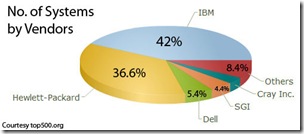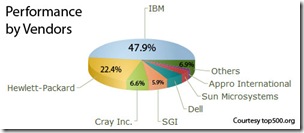This weekend I heard a few guys from IBM India getting really excited about the next-generation microprocessor called Power 7 which will be released in H1 2010. The Power 7 processor is still not a final design but nonetheless, it is turning out to be an awesome processor. IBM’s latest plans show that Power 7 will be a 8-core processor, clocked at anywhere between 3.6Ghz-4.0Ghz.
Power 7 is a completely new architecture and is being developed at Austin, Böblingen, Rochester Research Centers. There are rumors that Opteron and Power 7 may share a common socket, but that doesn’t seem to be the case in the current design of the processor. But I got hints that things on the socket front could be changed during the final few weeks.
Power 7 is also a multi-thread per core CPU and current designs suggest it can execute about 4 threads per core. It still isn’t running optimally at the moment, but the target is to achieve full performance on all the 4 threads. This still makes Sun’s Rock the multi-threading king in the next-generation of processors. But IBM is high on the number crunching game. Each Power 7 core will be 32GFlops and that means on a 8-cores it going to output at 256GFlops. That’s no mean achievement!
Unlike the Power 6, which had its main aim towards improving single-core performance and max clocked at 6Ghz in prototypes, the Power 7 is working towards a multi-core, multi-threaded processor. From Intel to Sun, everyone has realized the potential efficiency of multi-core design and IBM hopes to lead the pack with Power 7. And to become the winner of the lot, Power 7 will compete against Sun’s Rock (UltraSPARC T2 Processors), Intel’s Itanium and Xeon (Nehelam-based) to some extent as well as its friendly technology partner AMD’s Opteron. IBM’s main goal with Power 7 is at the High-Performance Computing markets and supercomputers, where IBM already rules the roost.
If you look for stats at Top500 Supercomputers from around the world, you’ll realize what I mean by IBM ruling the roost. IBM has lots of BlueGene machines that use the old PowerPC processors, but not many newer generation processors. The reason to this is two-fold. IBM’s last generation processor Power 6 and to some extent Power 5 isn’t very power efficient. Power 6 heats up quite a bit and would require massive engineering skills to bring 1000s of these chips together inside a supercomputer. On the other hand, IBM has plans to mix-match Power 7 and Cell microprocessors in future supercomputers. Cell processors are known to be good specialized FP units and matching it with Power 7, IBM hopes to reach more than 10 petaflop from a supercomputer.


3 comments:
Hi Saptarshi,
I am Richa from SiliconIndia. I am also an avid blogger for a while now and participating actively in Indian blogosphere. I read your blog posting and found them very interesting and informative. We would love to see a copy of your blogs posted here, whenever you are posting it on blogger.com. Here are some of the benefits of posting your blogs here:
We have a strong community of 500,000 Indian professionals
Best blogs of 2008 to be published in a book "SiliconIndia bLoG PrinT"
Best blog to be printed in SliconIndia & SmartTechie magazines each month
Chance to be featured on homepage everyday
We appreciate your community initiative here and in helping build a more powerful India! Also, if you have any ideas or want to volunteer to help for SiliconIndia, we would be more than excited to get your help. Pls mail me back at richa@siliconindia.com with your suggestions and feedback.
Richa
Blog Editor- SiliconIndia
I've heard that HCL and IBM are collaborating on the design of next-gen POWER processors. Did u hear all this info from IBM engg or HCL guys???
BTW, I never believed that Power and IBM can share the same socket... It was complete bullshit rumour from AMD to keep its shares up!
The government will create necessary environment to attract project developers to invest in research and domestic manufacturing of solar power equipment.
Solar Panel In India
Post a Comment